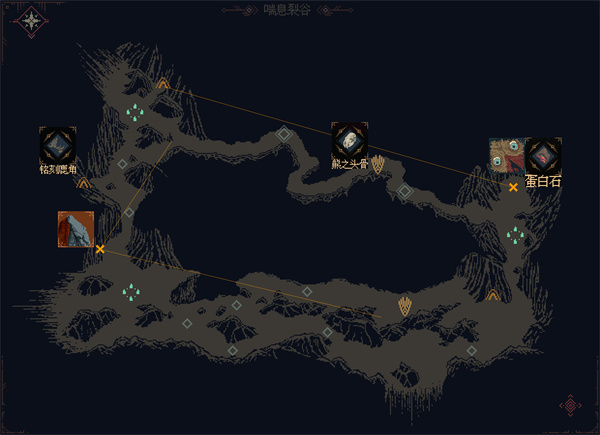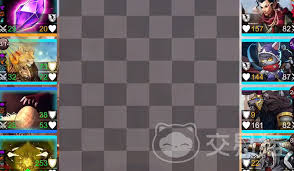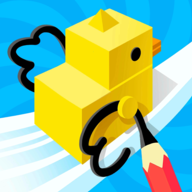SDL入门教程(九):3、文本反馈“按键”信息
时间:2010-12-27 来源:landuochong
3.1:一些小的修改
我觉得写C++的程序,一是看起来确实比较C++一点,二是相对于C的“精炼”,C++要的是“健壮”。所以,其实我不太满意用C风格字符串作为 ScreenSurface的成员数据,所以做了修改。这也是为了在程序中构建ScreenSurface对象的时候可以使用string。
我觉得写C++的程序,一是看起来确实比较C++一点,二是相对于C的“精炼”,C++要的是“健壮”。所以,其实我不太满意用C风格字符串作为 ScreenSurface的成员数据,所以做了修改。这也是为了在程序中构建ScreenSurface对象的时候可以使用string。
class ScreenSurface
{
private:
//
std::string windowName;
public:
//
ScreenSurface(int w, int h, const std::string& window_name = "NULL", int b = 0, Uint32 f = 0);
}; 相应的,我们修改了2个构造函数。
{
private:
//

std::string windowName;
public:
//

ScreenSurface(int w, int h, const std::string& window_name = "NULL", int b = 0, Uint32 f = 0);
}; 相应的,我们修改了2个构造函数。
ScreenSurface::ScreenSurface():
width(640), height(480), bpp(32), flags(0), windowName("NULL")
{
if ( screenNum > 0 )
throw ErrorInfo("DONOT create more than ONE screen!");
if ( SDL_Init(SDL_INIT_VIDEO < 0 ) )
throw ErrorInfo(SDL_GetError());
pScreen = SDL_SetVideoMode(width, height, bpp, flags);
screenNum++;
}
ScreenSurface::ScreenSurface(int w, int h, const std::string& window_name, int b, Uint32 f):
width(w), height(h), bpp(b), flags(f)
{
if ( screenNum > 0 )
throw ErrorInfo("DONOT create more than ONE screen!");
if ( SDL_Init(SDL_INIT_VIDEO < 0 ) )
throw ErrorInfo(SDL_GetError());
pScreen = SDL_SetVideoMode(width, height, bpp, flags);
screenNum++;
if ( window_name != "NULL" ) {
windowName = window_name;
SDL_WM_SetCaption(windowName.c_str(), 0);
}
else
windowName = "NULL";
}
width(640), height(480), bpp(32), flags(0), windowName("NULL")
{
if ( screenNum > 0 )
throw ErrorInfo("DONOT create more than ONE screen!");
if ( SDL_Init(SDL_INIT_VIDEO < 0 ) )
throw ErrorInfo(SDL_GetError());
pScreen = SDL_SetVideoMode(width, height, bpp, flags);
screenNum++;
}
ScreenSurface::ScreenSurface(int w, int h, const std::string& window_name, int b, Uint32 f):
width(w), height(h), bpp(b), flags(f)
{
if ( screenNum > 0 )
throw ErrorInfo("DONOT create more than ONE screen!");
if ( SDL_Init(SDL_INIT_VIDEO < 0 ) )
throw ErrorInfo(SDL_GetError());
pScreen = SDL_SetVideoMode(width, height, bpp, flags);
screenNum++;
if ( window_name != "NULL" ) {
windowName = window_name;
SDL_WM_SetCaption(windowName.c_str(), 0);
}
else
windowName = "NULL";
}
第二个地方,我修改了TextSurface构造函数的参数顺序,并且将默认的字体改为Windows都自带的“新罗马时代”字体times.ttf。我将字体参数放在最后,将字体大小参数提前了,这样更符合习惯上的使用规律。
class TextSurface: public DisplaySurface
{
public:
TextSurface(const std::string& msg_name, const std::string& message, const ScreenSurface& screen,
Uint8 r = 0xFF, Uint8 g = 0xFF, Uint8 b = 0xFF,
int ttf_size = 28, const std::string& ttf_fileName = "times.ttf");
~TextSurface();
};
{
public:
TextSurface(const std::string& msg_name, const std::string& message, const ScreenSurface& screen,
Uint8 r = 0xFF, Uint8 g = 0xFF, Uint8 b = 0xFF,
int ttf_size = 28, const std::string& ttf_fileName = "times.ttf");
~TextSurface();
};
(在DisplaySurface里相应的构造函数也做类似的修改,略)
3.2:回顾SDL事件轮询
SDL_PollEvent()的作用,是事件一旦被触发,就会响应一次,注意它的响应并不是连续不断的。比如你按下某个键,即触发了一次事件。即使你按着不松开,也仅仅是触发了一次,所以SDL_PollEvent()也只响应一次。
下面的程序,演示键盘事件中,方向键被按下后的反馈信息。
3.3:演示程序
//UVi Soft (2008)
//Long Fei (lf426), E-mail: [email protected]
#include "SurfaceClass.h"
int game(int argc, char* argv[]);
int main(int argc ,char* argv[])
{
int mainRtn = 0;
try {
mainRtn = game(argc, argv);
}
catch ( const ErrorInfo& info ) {
info.show();
return -1;
}
return mainRtn;
}
int game(int argc ,char* argv[])
{
//Create a SDL screen.
const int SCREEN_WIDTH = 640;
const int SCREEN_HEIGHT = 480;
const std::string WINDOW_NAME = "Key Presses";
ScreenSurface screen(SCREEN_WIDTH, SCREEN_HEIGHT, WINDOW_NAME);
//Fill background.(default is black)
screen.fillColor();
screen.flip();
//Load a textSurface
TextSurface upMessage("upMsg", "Up was pressed.", screen);
TextSurface downMessage("downMsg", "Down was pressed.", screen, 0xFF, 0, 0);
TextSurface leftMessage("leftMsg", "Left was pressed.", screen, 0, 0xFF, 0);
TextSurface rightMessage("rightMsg", "Right was pressed.", screen, 0, 0, 0xFF);
TextSurface otherMessage("otherMsg", "Other key was pressed.", screen, 100, 100, 100, 35);
//Main loop.Press ESC or click X to quit.
bool gameOver = false;
SDL_Event gameEvent;
int x = 200;
int y = 200;
while( gameOver == false ){
while ( SDL_PollEvent(&gameEvent) != 0 ){
if ( gameEvent.type == SDL_KEYDOWN ){
screen.fillColor();
switch ( gameEvent.key.keysym.sym ){
case SDLK_UP:
upMessage.blit(x, y--);
break;
case SDLK_DOWN:
downMessage.blit(x, y++);
break;
case SDLK_LEFT:
leftMessage.blit(x--, y);
break;
case SDLK_RIGHT:
rightMessage.blit(x++, y);
break;
default:
otherMessage.blit(x, y);
}
screen.flip();
}
if ( gameEvent.type == SDL_QUIT ){
gameOver = true;
}
if ( gameEvent.type == SDL_KEYUP ){
if ( gameEvent.key.keysym.sym == SDLK_ESCAPE ){
gameOver = true;
}
}
}
}
return 0;
}
是用TextSurface反馈鼠标事件的信息。我想到的第一个例子,很自然就是反馈鼠标所在坐标的位置。这里涉及到一个基础的问题,即鼠标位置显然不是 用字符串表示的。SDL给我们的反馈信息是int,我们需要用TextSurface将int构建成可以被blit到ScreenSurface上的面, 需要做的第一件事情,是将int转换为string。
我的思路是这样的:首先找到int的数位数;然后依次从高位读取数字,之后将这个位去掉(通常减掉是最简单的);依次记录这些数字,转换成string,然后将这些数字“加”(字符串的合并)起来。
头文件如下:
//Long Fei (lf426), E-mail: [email protected]
#include "SurfaceClass.h"
int game(int argc, char* argv[]);
int main(int argc ,char* argv[])
{
int mainRtn = 0;
try {
mainRtn = game(argc, argv);
}
catch ( const ErrorInfo& info ) {
info.show();
return -1;
}
return mainRtn;
}
int game(int argc ,char* argv[])
{
//Create a SDL screen.
const int SCREEN_WIDTH = 640;
const int SCREEN_HEIGHT = 480;
const std::string WINDOW_NAME = "Key Presses";
ScreenSurface screen(SCREEN_WIDTH, SCREEN_HEIGHT, WINDOW_NAME);
//Fill background.(default is black)
screen.fillColor();
screen.flip();
//Load a textSurface
TextSurface upMessage("upMsg", "Up was pressed.", screen);
TextSurface downMessage("downMsg", "Down was pressed.", screen, 0xFF, 0, 0);
TextSurface leftMessage("leftMsg", "Left was pressed.", screen, 0, 0xFF, 0);
TextSurface rightMessage("rightMsg", "Right was pressed.", screen, 0, 0, 0xFF);
TextSurface otherMessage("otherMsg", "Other key was pressed.", screen, 100, 100, 100, 35);
//Main loop.Press ESC or click X to quit.
bool gameOver = false;
SDL_Event gameEvent;
int x = 200;
int y = 200;
while( gameOver == false ){
while ( SDL_PollEvent(&gameEvent) != 0 ){
if ( gameEvent.type == SDL_KEYDOWN ){
screen.fillColor();
switch ( gameEvent.key.keysym.sym ){
case SDLK_UP:
upMessage.blit(x, y--);
break;
case SDLK_DOWN:
downMessage.blit(x, y++);
break;
case SDLK_LEFT:
leftMessage.blit(x--, y);
break;
case SDLK_RIGHT:
rightMessage.blit(x++, y);
break;
default:
otherMessage.blit(x, y);
}
screen.flip();
}
if ( gameEvent.type == SDL_QUIT ){
gameOver = true;
}
if ( gameEvent.type == SDL_KEYUP ){
if ( gameEvent.key.keysym.sym == SDLK_ESCAPE ){
gameOver = true;
}
}
}
}
return 0;
}
是用TextSurface反馈鼠标事件的信息。我想到的第一个例子,很自然就是反馈鼠标所在坐标的位置。这里涉及到一个基础的问题,即鼠标位置显然不是 用字符串表示的。SDL给我们的反馈信息是int,我们需要用TextSurface将int构建成可以被blit到ScreenSurface上的面, 需要做的第一件事情,是将int转换为string。
我的思路是这样的:首先找到int的数位数;然后依次从高位读取数字,之后将这个位去掉(通常减掉是最简单的);依次记录这些数字,转换成string,然后将这些数字“加”(字符串的合并)起来。
头文件如下:
//UVi Soft (2008)
//Long Fei (lf426), E-mail: [email protected]
//FileName: int_to_string.h
#ifndef INT_TO_STRING_H_
#define INT_TO_STRING_H_
#include <iostream>
#include <string>
#include <vector>
int int_power(int base, int exp);
std::string int_to_string(int num);
#endif 其中,int_to_string()是我们需要构建的函数,int_power()是求一个数的整数幂的函数。这么简单的算法,我们就自己写吧。至于用 到vector,按照我的思路,我们需要的数据结构显然应该是“队列”(先进先出)。不过真得感谢STL,用vector显然不是最优化的,但是肯定是最 “通俗”的,因为即使是作为非专业的队列(或者栈),vector也已经为我们提供了必要的方法,比如推入(push_back)。
下面我就把程序说明夹在程序中间了。原因是本人英语太菜,简单描述还能忍,描述算法就有点不能忍了-_-!!!。另外,尽管我英语这水平,我还是希望程序里面别用中文注释的好。这种事情,您见过一次乱码,就总是得恶心一辈子。
//Long Fei (lf426), E-mail: [email protected]
//FileName: int_to_string.h
#ifndef INT_TO_STRING_H_
#define INT_TO_STRING_H_
#include <iostream>
#include <string>
#include <vector>
int int_power(int base, int exp);
std::string int_to_string(int num);
#endif 其中,int_to_string()是我们需要构建的函数,int_power()是求一个数的整数幂的函数。这么简单的算法,我们就自己写吧。至于用 到vector,按照我的思路,我们需要的数据结构显然应该是“队列”(先进先出)。不过真得感谢STL,用vector显然不是最优化的,但是肯定是最 “通俗”的,因为即使是作为非专业的队列(或者栈),vector也已经为我们提供了必要的方法,比如推入(push_back)。
下面我就把程序说明夹在程序中间了。原因是本人英语太菜,简单描述还能忍,描述算法就有点不能忍了-_-!!!。另外,尽管我英语这水平,我还是希望程序里面别用中文注释的好。这种事情,您见过一次乱码,就总是得恶心一辈子。
//UVi Soft (2008)
//Long Fei (lf426), E-mail: [email protected]
#include "int_to_string.h"
int int_power(int base, int exp)
{
int result = 1;
for (int i = exp; i > 0; i-- )
result*=base;
return result;
} 这是个很简单的求幂的算法。其实我们在程序中,只需要用到求10的n次幂,所以,实际上我们还可以写得更加有针对一点。
//Long Fei (lf426), E-mail: [email protected]
#include "int_to_string.h"
int int_power(int base, int exp)
{
int result = 1;
for (int i = exp; i > 0; i-- )
result*=base;
return result;
} 这是个很简单的求幂的算法。其实我们在程序中,只需要用到求10的n次幂,所以,实际上我们还可以写得更加有针对一点。
std::string int_to_string(int num)
{
bool negative = false;
if ( num < 0 ){
negative = true;
num = -num;
} 这开始写转换函数了。首先我们判定int是否为负。如果是,我们把它变成其相反数,然后与正数一样转换,最后在前面加上“-”就OK了。
{
bool negative = false;
if ( num < 0 ){
negative = true;
num = -num;
} 这开始写转换函数了。首先我们判定int是否为负。如果是,我们把它变成其相反数,然后与正数一样转换,最后在前面加上“-”就OK了。
int bitNum = 1;
for ( int i = num; i > 9; i/=10 )
bitNum++; bitNum是这个int的数位数。比如3就是1位,1024就是4位。
for ( int i = num; i > 9; i/=10 )
bitNum++; bitNum是这个int的数位数。比如3就是1位,1024就是4位。
std::vector<int> eachNum;
for ( int i = bitNum, temp = num; i > 0; i-- ){
int highBit = int(temp/int_power(10, (i-1)));
eachNum.push_back(highBit);
temp-=(highBit*int_power(10, (i-1)));
} 我们通过vector数组纪录每个数位上的数字,从高位到低位。需要说明的是,n位的数字是10的n-1次方幂。比如1024是4位,而1000是10的3次方幂。所以,我们这里用的是i-1而非i。
for ( int i = bitNum, temp = num; i > 0; i-- ){
int highBit = int(temp/int_power(10, (i-1)));
eachNum.push_back(highBit);
temp-=(highBit*int_power(10, (i-1)));
} 我们通过vector数组纪录每个数位上的数字,从高位到低位。需要说明的是,n位的数字是10的n-1次方幂。比如1024是4位,而1000是10的3次方幂。所以,我们这里用的是i-1而非i。
std::string str;
if ( negative == true )
str = "-";
for ( std::vector<int>::iterator pTemp = eachNum.begin(); pTemp != eachNum.end(); pTemp++ ){
switch ( *pTemp ){
case 0:
str+="0";
break;
case 1:
str+="1";
break;
case 2:
str+="2";
break;
case 3:
str+="3";
break;
case 4:
str+="4";
break;
case 5:
str+="5";
break;
case 6:
str+="6";
break;
case 7:
str+="7";
break;
case 8:
str+="8";
break;
case 9:
str+="9";
break;
default:
break;
}
}
return str;
} 最后,我们用了STL的方法将每个数字转换成std::string的字符串,然后将这些字符串合并起来,作为函数的返回值。
if ( negative == true )
str = "-";
for ( std::vector<int>::iterator pTemp = eachNum.begin(); pTemp != eachNum.end(); pTemp++ ){
switch ( *pTemp ){
case 0:
str+="0";
break;
case 1:
str+="1";
break;
case 2:
str+="2";
break;
case 3:
str+="3";
break;
case 4:
str+="4";
break;
case 5:
str+="5";
break;
case 6:
str+="6";
break;
case 7:
str+="7";
break;
case 8:
str+="8";
break;
case 9:
str+="9";
break;
default:
break;
}
}
return str;
} 最后,我们用了STL的方法将每个数字转换成std::string的字符串,然后将这些字符串合并起来,作为函数的返回值。
相关阅读 更多 +










